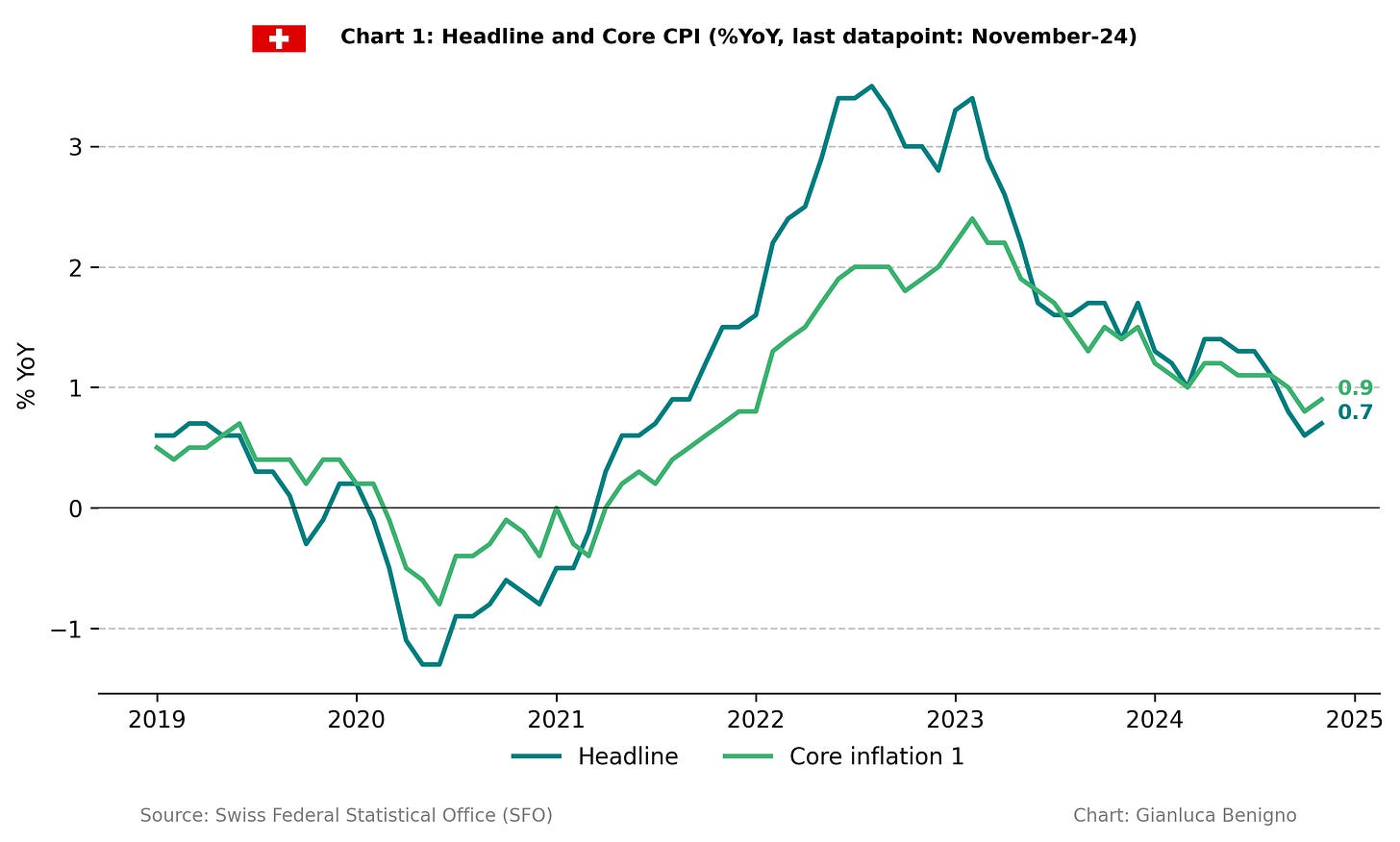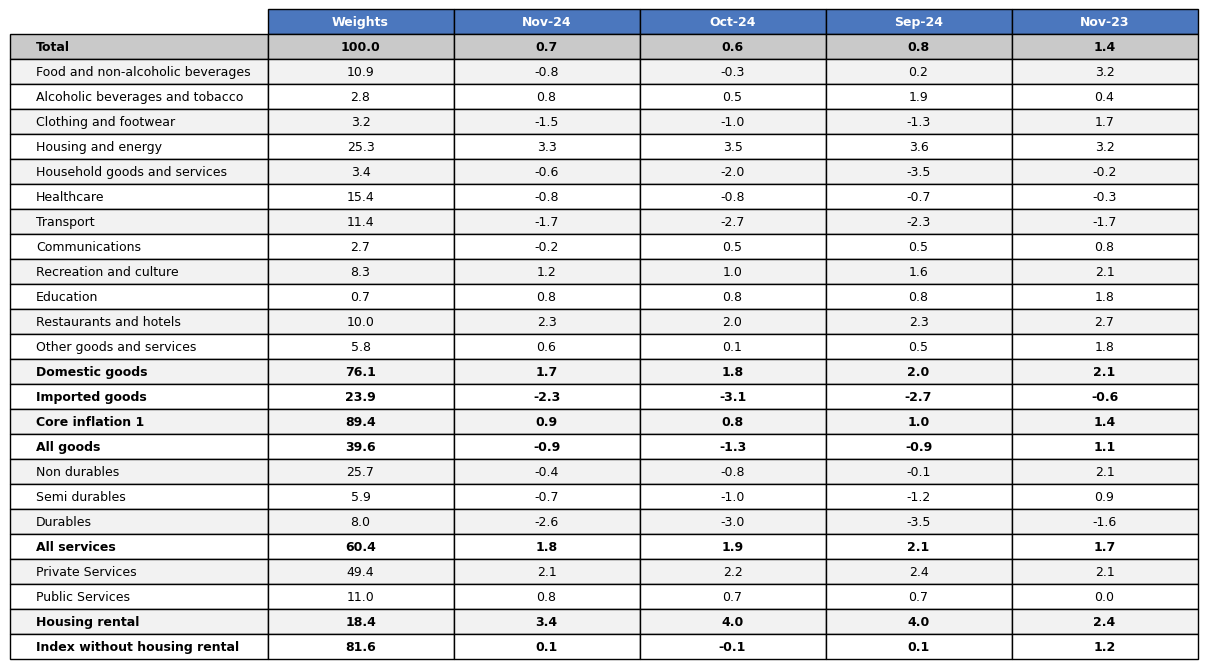Switzerland November-24 CPI Inflation Report
Persistently Low Inflationary Environment Continues in Switzerland
Key takeaways:
In November, the Swiss Consumer Price Index (CPI) rose by 0.7% year-on-year (YoY), higher than October's 0.6% YoY figure and in line with the consensus forecast. On a month-on-month (MoM) basis, the headline CPI decreased by 0.1%, the same decline recorded in October.
The Core CPI increased by 0.9% YoY in November, up from the 0.8% YoY observed in October and in line with the consensus forecast. However, the Core CPI index did not change relative to October, while in October a 0.1% MoM increase was recorded.
The services sector was the primary driver of rising prices, experiencing a 1.8% YoY increase in November. In contrast, the goods sector declined for the seventh time in 2024, with a decrease of 0.9% YoY versus a decline of 1.3% YoY in October.
Housing rentals have trended upward since November 2023. However, they showed signs of moderation in November, recording an increase of 3.4 % YoY, down from the 4.0% YoY recorded in the previous observation (i.e., August through October). This decline signals that the peak in housing rental inflation was reached in the past three months and from now on we might expect further moderation in this component, considering the easing cycle by the SNB.
These results are consistent with a common dichotomy faced by Central Banks in (major) advanced economies: goods prices are in a deflationary territory while service price inflation is slowly adjusting.
A parallel dichotomy arises in Switzerland by examining import and domestic prices, with import prices declining by 2.3% YoY (versus a 3.1% YoY decline in October) and domestic prices rising at 1.7% YoY (lower than the 1.8% YoY recorded in October and the 2% recorded in September).
From the SNB's perspective, the current release, coupled with the October release, suggests a persistent disinflationary outlook that might lead to a further revision of the conditional inflation path outlined in its latest monetary policy assessment. Another aspect to note is the broadening of deflationary pressures among several components of the CPI basket especially in the month-on-month readings.
Excluding housing rentals, the CPI inflation ticked by 0.1% YoY in November, higher than the 0.1% YoY decrease reported in October after the 0.1% YoY increase recorded in September.
The current release tends to support the continuation of the SNB's easing cycle with a further 25bps cut in December.
Related Posts
Switzerland October 24 -CPI Inflation Report (previous release)
Switzerland September 24-CPI Inflation Report (previous release)
The SNB’s Forward-Looking Compromise (analysis of SNB’s September policy decision)
Switzerland August 24-CPI Inflation Report (previous release)
The SNB’s Challenging Rebalancing Act (analysis of SNB policy and Catch-22 effect for the SNB)
The SNB sets the time (analysis of SNB policy and Catch-22 effect for the SNB)
Switzerland July 24-CPI Inflation Report (previous release)
Inflation Report
Consumer prices rose by 0.7% year-on-year (YoY) in November 2024, above October’s increase of 0.6% YoY. On a month-on-month (MoM) basis, consumer prices declined by 0.1%, following an identical decline in October.
Core CPI, which excludes fresh and seasonal products as well as energy and fuels, increased by 0.9% year-on-year (YoY) in November (Chart 1), up from the 0.8% YoY observed in October. On a month-on-month basis, Core CPI remained unchanged, compared to a 0.1% increase in October.
Similarly to trends seen in other advanced countries, the services sector, rather than the goods sector, is the main driver of rising prices (Chart 2). In November, services saw a 1.8% YoY increase, lower than the 1.9% recorded in October. Meanwhile, the goods sector experienced a decline of 0.9% YoY, up from the 1.3% YoY dip in October after the 0.9% YoY decline of September.
Upon examining the more disaggregated data (refer to Tables 1 and 2), it is evident that, like other advanced economies, housing rentals are the primary driver of inflation (as shown in Chart 3). In Switzerland, this component of the Consumer Price Index (CPI) is adjusted every three months and November is the month in which the new three-month data point is reported. In November the housing rental component rose by 3.4% YoY, down from the 4.0% YoY reported in October, September, and August. As noted previously, the stubbornness exhibited in housing rental is consistent with the Catch-22 effect where monetary policy hikes lead to higher mortgage rates that tend to exacerbate domestic inflation. Excluding housing rentals, in November the CPI inflation increased by 0.1% year-on-year, higher than the 0.1% YoY decline reported in October after the 0.1% YoY increase of September.
Another important classification from Switzerland's perspective is the distinction between domestic and imported inflation (see Chart 4). In November, domestic inflation rose by 1.7% year-on-year, lower than the 1.8% YoY recorded in October. On a monthly basis, domestic inflation declined by 0.1% MoM, repeating the decline reported in October. In contrast, imported inflation decreased by 2.3% year-on-year, which is a lower decline than the -3.1% recorded in October. On a monthly basis, imported inflation fell by 0.4%, tumbling down from the -0.1% seen in October.
The Swiss Federal Statistical Office also makes available a measure of the Harmonized Price Index of Consumer Prices (The Harmonized Index of Consumer Prices (HICP) is an indicator that the member states of EU and EFTA calculate based on a harmonized method and that allows comparing inflation internationally). In November, the HICP increased by 0.7% on a year-on-year basis, the same increase as in October but slightly short of the consensus forecast of 0.8%.
Summary
The report presents a similar disinflationary outlook as the October release. In addition to the ongoing deflationary trend in goods and the effects of imported inflation, it's important to highlight the decline in domestic inflation on a month-to-month basis (now for three months in a row).
An additional indicator of the almost deflationary context is the behavior of CPI inflation excluding housing rentals. In November, this measure increased by 0.1% year-on-year, contrasting with the 0.1% decline seen in October after the 0.1% rise in September.
The next monetary policy decision by the Swiss National Bank is this month (December). The current inflationary outlook is consistent with a 25bps cut by the SNB in December and probably a downward adjustment of the conditional inflation outlook.
Table 1: CPI by components (% YoY)
Source: Swiss Federal Statistical Office (FSO).
Table 2: CPI by components (% MoM)
Source: Swiss Federal Statistical Office (FSO).











Great note as usual! Any views on the likelihood of a bigger cut in December or if the SNB will take rates to zero or below (in 2025 or beyond)?
Thanks. I think that the release is broadly in line with the previous one. Moderation in housing rental and cuts in electricity prices will add to the disinflationary picture in 2025 and might require an adjustment in the conditional inflation forecast. Overall though, unless something happens, I don't see 50bps in December. I do see the possibility that SNB might reach very low rates in 2025. But I would wait to see how the new U.S. administration will shape its policy then.